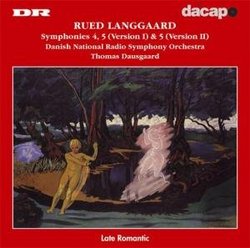| All Artists: Rued Langgaard, Thomas Dausgaard, Danish National Symphony Orchestra Title: Rued Langgaard: Symphonies No. 4 & 5 (Versions 1 and 2) Members Wishing: 0 Total Copies: 0 Label: Marco Polo Release Date: 8/20/2002 Genre: Classical Styles: Historical Periods, Modern, 20th, & 21st Century, Symphonies Number of Discs: 1 SwapaCD Credits: 1 UPC: 730099991520 |
Search - Rued Langgaard, Thomas Dausgaard, Danish National Symphony Orchestra :: Rued Langgaard: Symphonies No. 4 & 5 (Versions 1 and 2)
 | Rued Langgaard, Thomas Dausgaard, Danish National Symphony Orchestra Rued Langgaard: Symphonies No. 4 & 5 (Versions 1 and 2) Genre: Classical |
Larger Image |
CD Details |
CD ReviewsThe Odd Duck of Denmark Christopher Forbes | Brooklyn,, NY | 05/05/2003 (5 out of 5 stars) "Poor Rued Langgaard is the oddest of odd ducks from the 20th century. A prodigiously prolific composer, with an undoubted gift for unusual orchestrations, hiw music was nevertheless completely ignored in his native Denmark, and only a blip on the radar screen of most of Europe at the time. He was ferociously committed to Late-Romantic musical and philosophical impulses long after World War I sent them out of fashion. He held onto Theosophist beliefs throughout his life. But for all of his quirkiness, his music remains fascinating, if not completely successful, still in an odd way very compelling.The Langgaard 4th symphony was composed in 1916. Subtitled Leaf Fall, it is an unabashedly programmatic portrait of Autumn and it's moods. It's tonal idiom is definitely late-Romantic, particularly leaning toward the models of Niels Gade. But it is too quirky to be confused with that composer. The formal structures are so loose as to be nearly non-existent on the surface. Many themes enter and then leave, never to return again, while others come back in fleetingly, or so transformed that they are almost unrecognizable. And even in the midst of this late-Romantic stew, there are moments that are curiously modern. The whole tone evocation of church bells toward the end of the piece is almost minimalist in effect, while there are sections that have "cloud" effects that look forward to Ligeti. Ultimately, the work is compelling for all of its quirkiness. It is obvious that Langgaard had something original to say, though it is also so very odd. The Symphony No. 5 has a more circuitous history than the Fourth. Its genesis was an orchestral fantasy called Summer Legend Drama. It was then revised as Symphonic Festival Play in 1920. In 1926 Langgaard compressed the work into one movement and created the Symphony No. 5 in its first version. Then in 1931 he created a second Symphony No.5 based on the Summer Legend Drama, with newly composed material. Both versions of the symphonies share material, and yet they differ so significantly as to be almost different pieces. The First version is almost granite-like in its force. Theme blocks vie for dominance rather like organ orchestration. The form is loose, with regular recurring themes but little or no development of themes or organic transformation of material. The work is effective despite this, though perhaps not completely compelling. The Lento misterioso section is quite haunting though. Consisting of whirls of string lines, an insistent ominous ostinato in the winds and gradually more and more terrifying solo violin cadenzas the section portrays the nix from Danish folk lore - a supernatural creature who uses his violin playing to lure humans to their deaths. The Second version of the Symphony starts with lovely atmospheric string whirls and then moves into a more insistent and slightly darker version of the main theme heard in version one. Langgaard tightens up the form in this version, creating a more even flow from section to section and greater continuity between motives. When the opening motive comes back in the "Sonata and variations" movement there is a sense of inevitability and climax to the recapitulation that is missing from the first version. On the other hand, what is gained in formal coherence and structure is lost in quirky originality. Gone are the moments of tonal instability and gone too is the haunting violin cadenzas that close the first version. In his quest for coherence, Langgaard gave up much that was precious in these works.Performances on this CD are quite good as far as I can tell. Dausgaard seems to believe strongly in his mission to make people more aware of this oddity of Danish music. I must give this CD five stars, because it is a beautiful presentation of one of the most interesting forgotten composers of the twentieth century. Is it music to rival the composers of the ages? No...but it is enjoyable, quirky, odd and oddly endearing. If Langgaard is never destined to be a staple of the concert hall (and he isn't) still these works should be better known than they are. And yes it would be really nice to hear them live sometime!"
|
